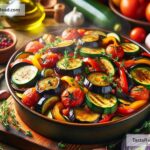The Story of the French Quiche
When you think of French food, elegant dishes like croissants, baguettes, and soufflés might come to mind. But there’s one savory dish that holds a special place in French cuisine: the quiche. It’s not only delicious but also tied to a surprisingly interesting history. The French quiche is a dish that has traveled through time and across cultures to become the global favorite it is today.
What is a Quiche?
Simply put, a quiche is a savory tart made with a flaky pastry crust filled with eggs, cream, cheese, and other ingredients like vegetables, meat, or seafood. The dish is baked until golden brown and has a creamy texture. The most famous version is the quiche Lorraine, which includes smoky bacon or lardons. Quiche is perfect for breakfast, lunch, or dinner, and can be served warm or cold.
The Origin of Quiche
Surprisingly, the quiche didn’t originate in France. Its roots trace back to Germany! The word “quiche” comes from the German word “kuchen,” which means cake. The dish first appeared in the medieval region of Lothringen, an area that was often disputed between France and Germany. Today, this region is called Lorraine, and it’s a French territory, making quiche a proud part of French culinary tradition.
The earliest quiches were very simple—made with a bread dough crust instead of the buttery pastry we use today. The filling consisted of eggs, cream, and lardons (small chunks of cured pork). Over time, the recipe evolved, replacing the bread crust with flaky pastry and adding more ingredients like cheese.
How Quiche Became French
During the fifteenth century, Lorraine became a French region, and the quiche became more popular in French households. French chefs embraced the recipe and started experimenting with new versions, adding flavorful ingredients. Over the centuries, quiche went from being a humble dish to one served in upscale Parisian cafes.
By the 19th and 20th centuries, recipes for quiche began appearing in cookbooks, and its reputation grew internationally. Today, quiche is considered one of France’s culinary staples, proudly served in restaurants and homes across the country.
The Rise of Quiche Lorraine
When talking about quiche, the quiche Lorraine is the superstar. Its straightforward filling of eggs, cream, bacon, and sometimes Gruyère cheese makes it irresistibly savory. This version encapsulates the essence of the original recipe, yet it is elevated with French finesse.
While modern versions often include cheese, purists argue that the traditional quiche Lorraine shouldn’t contain any. Whatever choice you prefer, there’s no denying that quiche Lorraine paved the way for countless variations of this marvelous dish.
Quiche Around the World
As French cuisine spread globally, so did quiche. Today, people everywhere enjoy the dish, often customizing it to suit local ingredients and tastes. In England, you’ll find quiches with salmon or spinach. In the United States, popular versions include mushrooms, broccoli, and even spicy peppers.
In fact, quiche has become a symbol of versatility in cooking. Its base of eggs and cream allows endless variations, making it a great way to use leftover ingredients. It’s also loved by vegetarians, who can skip the meat and add fresh veggies, herbs, or even tofu.
Why Is Quiche So Popular?
The answer is simple: quiche is delicious, easy to make, and adaptable. Its rich flavor and flaky crust appeal to people of all ages. It’s also a perfect dish for entertaining guests, as it can be prepared in advance and served either warm or cold.
Quiche works well for every occasion—whether it’s served at a fancy brunch, a casual picnic, or a quick weekday dinner. And because of its adaptability, chefs and home cooks alike have endless fun creating new versions.
Making Your Own French Quiche
Want to experience the joy of quiche for yourself? Here’s a simple guide to making your own:
-
Crust: Use store-bought pastry or make your own from scratch. Roll it out into a tart pan and blind bake it (bake it without the filling) for 10–15 minutes.
-
Filling: Whisk together eggs, cream, and seasonings like salt, pepper, and nutmeg. Add in your favorite ingredients: bacon, cheese, spinach, mushrooms, or anything you like.
-
Assemble: Pour the egg mixture into the crust and sprinkle your additional ingredients evenly.
-
Bake: Pop the quiche into the oven and bake at 375°F (190°C) for 30–40 minutes, or until golden brown and set in the center.
-
Enjoy: Let it cool for a few minutes before slicing. Serve with salad for a complete meal.
Conclusion
The story of the French quiche is one of transformation and adaptation. From its humble beginnings in Germany to its beloved status in French cuisine, quiche has earned global recognition for good reason. It’s a dish that brings people together, whether you’re sharing it with family or enjoying it at a cafe in Paris.
So the next time you taste a slice of buttery, savory quiche, remember its journey—how it crossed borders, survived centuries, and found its way to your plate. In every bite, you’re savoring a little piece of history!


